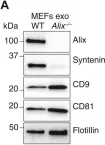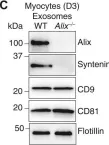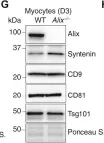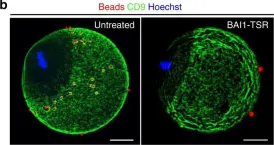The IL-23-Th17 axis is responsible for neutrophilic inflammation in various inflammatory diseases. Here, we discover a potential pathway to inhibit neutrophilic asthma. In our neutrophil-dominant asthma (NDA) model, single-cell RNA-seq analysis identifies a subpopulation of CD39+CD9+ interstitial macrophages (IMs) suppressed by IL-23 in NDA conditions but increased by an IL-23 inhibitor αIL-23p19. Adoptively transferred CD39+CD9+ IMs suppress neutrophil extracellular trap formation (NETosis), a representative phenotype of NDA, and also Th17 cell activation and neutrophilic inflammation. CD39+CD9+ IMs first attach to neutrophils in a CD9-dependent manner, and then remove ATP near neutrophils that contribute to NETosis in a CD39-dependent manner. Transcriptomic data from asthmatic patients finally show decreased CD39+CD9+ IMs in severe asthma than mild/moderate asthma. Our results suggest that CD39+CD9+ IMs function as a potent negative regulator of neutrophilic inflammation by suppressing NETosis in the IL-23-Th17 axis and can thus serve as a potential therapeutic target for IL-23-Th17-mediated neutrophilic asthma.
© 2024. The Author(s).
Product Citations: 57
In Nature Communications on 4 October 2024 by Han, S., Kim, B., et al.
-
Mus musculus (House mouse)
Preprint on BioRxiv : the Preprint Server for Biology on 23 September 2024 by Matoba, K., Kochi, T., et al.
Various states of microglia appear in neuroinflammation, but their impact on brain function and behavior is not fully understood. Here we report that synapse engulfing microglia in the thalamus are crucial for cognitive impairment after cortical brain injury. Region-specific manipulations of reactive microglia in the chronic phase of injuries showed that microglial changes in the thalamus, but not in the hippocampus, impaired recognition memory. Single-cell RNA-sequencing analysis revealed the enrichment of synapse engulfing microglia in the thalamus, which developed in a CD9-dependent manner and caused synaptic loss and recognition memory deficits. In the thalamus, the blood-brain barrier was disrupted, and extravasated γ-immunoglobulins (IgG) co-localized with synapse engulfing microglia. Fcγ receptor III blockade in the thalamus reduced synapse engulfing microglia, synapse loss, and recognition memory deficits. These findings demonstrate that the induction of synapse engulfing microglia in the thalamus by extravasated IgG/FcγRIII and CD9 signals causes recognition memory deficits after cortical brain injury.
-
Mus musculus (House mouse)
-
Neuroscience
In Nature Communications on 25 June 2024 by Paneru, B. D., Chini, J., et al.
Adipose tissue macrophages (ATMs) influence obesity-associated metabolic dysfunction, but the mechanisms by which they do so are not well understood. We show that miR-6236 is a bona fide miRNA that is secreted by ATMs during obesity. Global or myeloid cell-specific deletion of miR-6236 aggravates obesity-associated adipose tissue insulin resistance, hyperglycemia, hyperinsulinemia, and hyperlipidemia. miR-6236 augments adipocyte insulin sensitivity by inhibiting translation of negative regulators of insulin signaling, including PTEN. The human genome harbors a miR-6236 homolog that is highly expressed in the serum and adipose tissue of obese people. hsa-MIR-6236 expression negatively correlates with hyperglycemia and glucose intolerance, and positively correlates with insulin sensitivity. Together, our findings establish miR-6236 as an ATM-secreted miRNA that potentiates adipocyte insulin signaling and protects against metabolic dysfunction during obesity.
© 2024. The Author(s).
-
Mus musculus (House mouse)
-
Endocrinology and Physiology
In Vaccines on 1 June 2024 by Hu, J., Zhang, Z., et al.
The Bursa of Fabricius, an avian unique humoral immune organ, is instrumental to B cell development. Bursal-derived peptide BP9 fosters B-cell development and formation. Yet, the exact mechanism wherein BP9 impacts B cell differentiation and antigenic presentation remains undefined. In this paper, B cell activation and differentiation in the spleen cells from mice immunized with the AIV vaccine and BP9 were detected following flow cytometry (FCM) analysis. Furthermore, the molecular mechanism of BP9 in B cell differentiation in vivo was investigated with RNA sequencing technology. To verify the potential functional mechanism of BP9 in the antigenic presentation process, the transcriptome molecular basis of chicken macrophages stimulated by BP9 was measured via high-throughput sequencing technology. The results proved that when given in experimental dosages, BP9 notably accelerated total B cells, and enhanced B-cell differentiation and plasma cell production. The gene expression profiles of B cells from mice immunized with 0.01 mg/mL BP9 and AIV vaccine disclosed that 0.01 mg/mL BP9 initiated the enrichment of several biological functions and significantly stimulated key B-cell pathways in immunized mice. Crucially, a total of 4093 differentially expressed genes were identified in B cells with BP9 stimulation, including 943 upregulated genes and 3150 downregulated genes. Additionally, BP9 induced various cytokine productions in the chicken macrophage HD11 cells and activated 9 upregulated and 20 downregulated differential miRNAs, which were involved in various signal and biological processes. Furthermore, BP9 stimulated the activation of multiple transcription factors in HD11 cells, which was related to antigen presentation processes. In summary, these results suggested that BP9 might promote B cell differentiation and induce antigen presentation, which might provide the valuable insights into the mechanism of B cell differentiation upon bursal-derived immunomodulating peptide stimulation and provide a solid experimental groundwork for enhancing vaccine-induced immunity.
-
Mus musculus (House mouse)
-
Immunology and Microbiology
In The EMBO Journal on 11 December 2023 by Cocozza, F., Martin-Jaular, L., et al.
Cells secrete extracellular vesicles (EVs) and non-vesicular extracellular (nano)particles (NVEPs or ENPs) that may play a role in intercellular communication. Tumor-derived EVs have been proposed to induce immune priming of antigen presenting cells or to be immuno-suppressive agents. We suspect that such disparate functions are due to variable compositions in EV subtypes and ENPs. We aimed to characterize the array of secreted EVs and ENPs of murine tumor cell lines. Unexpectedly, we identified virus-like particles (VLPs) from endogenous murine leukemia virus in preparations of EVs produced by many tumor cells. We established a protocol to separate small EVs from VLPs and ENPs. We compared their protein composition and analyzed their functional interaction with target dendritic cells. ENPs were poorly captured and did not affect dendritic cells. Small EVs specifically induced dendritic cell death. A mixed large/dense EV/VLP preparation was most efficient to induce dendritic cell maturation and antigen presentation. Our results call for systematic re-evaluation of the respective proportions and functions of non-viral EVs and VLPs produced by murine tumors and their contribution to tumor progression.
© 2023 The Authors. Published under the terms of the CC BY NC ND 4.0 license.
-
WB
-
Mus musculus (House mouse)
-
Cancer Research
-
Immunology and Microbiology
In J Biol Chem on 1 October 2022 by Qiu, X., Campos, Y., et al.
Fig.4.A

-
WB
-
Mus musculus (House mouse)
Collected and cropped from J Biol Chem by CiteAb, provided under a CC-BY license
Image 1 of 11
In J Biol Chem on 1 October 2022 by Qiu, X., Campos, Y., et al.
Fig.4.F

-
WB
-
Mus musculus (House mouse)
Collected and cropped from J Biol Chem by CiteAb, provided under a CC-BY license
Image 1 of 11
In J Biol Chem on 1 October 2022 by Qiu, X., Campos, Y., et al.
Fig.4.B

-
WB
-
Mus musculus (House mouse)
Collected and cropped from J Biol Chem by CiteAb, provided under a CC-BY license
Image 1 of 11
In J Biol Chem on 1 October 2022 by Qiu, X., Campos, Y., et al.
Fig.4.E

-
WB
-
Mus musculus (House mouse)
Collected and cropped from J Biol Chem by CiteAb, provided under a CC-BY license
Image 1 of 11
In J Biol Chem on 1 October 2022 by Qiu, X., Campos, Y., et al.
Fig.4.C

-
WB
-
Mus musculus (House mouse)
Collected and cropped from J Biol Chem by CiteAb, provided under a CC-BY license
Image 1 of 11
In J Biol Chem on 1 October 2022 by Qiu, X., Campos, Y., et al.
Fig.4.G

-
WB
-
Mus musculus (House mouse)
Collected and cropped from J Biol Chem by CiteAb, provided under a CC-BY license
Image 1 of 11
In PLoS Biol on 1 April 2021 by Peruzzotti-Jametti, L., Bernstock, J. D., et al.
Fig.2.A

-
WB
-
Collected and cropped from PLoS Biol by CiteAb, provided under a CC-BY license
Image 1 of 11
In Int J Mol Sci on 10 April 2020 by Kim, H., Takegahara, N., et al.
Fig.1.B

-
IHC
-
Collected and cropped from Int J Mol Sci by CiteAb, provided under a CC-BY license
Image 1 of 11
In Int J Mol Sci on 10 April 2020 by Kim, H., Takegahara, N., et al.
Fig.1.C

-
IHC
-
Collected and cropped from Int J Mol Sci by CiteAb, provided under a CC-BY license
Image 1 of 11
In Nat Commun on 1 October 2019 by Rival, C. M., Xu, W., et al.
Fig.2.B

-
IHC-IF
-
Collected and cropped from Nat Commun by CiteAb, provided under a CC-BY license
Image 1 of 11
In PLoS One on 23 August 2011 by Kanatsu-Shinohara, M., Takashima, S., et al.
Fig.2.D

-
FC/FACS
-
Collected and cropped from PLoS One by CiteAb, provided under a CC-BY license
Image 1 of 11










